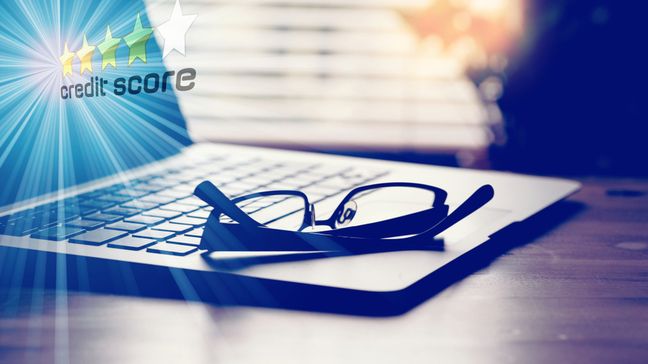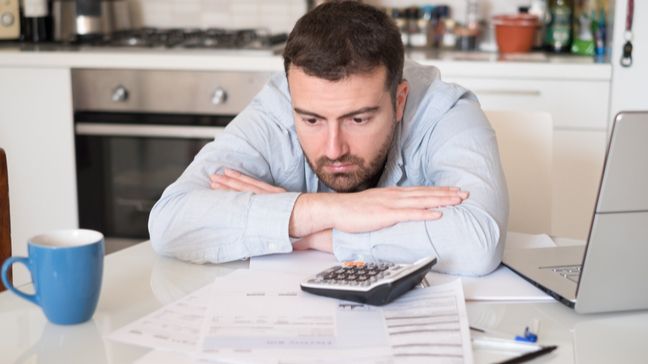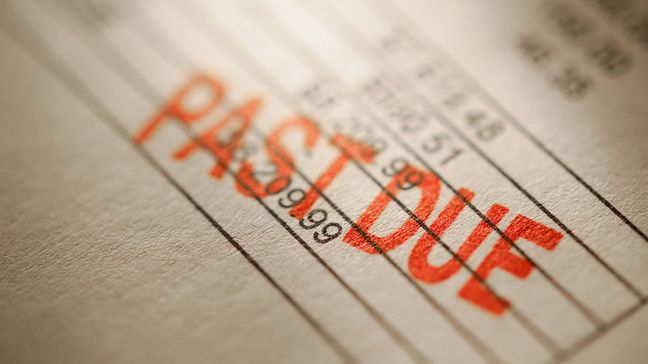You can’t fight what you can’t see. So if you’re on a mission to slay debt, first, you must know how much you really owe.
But tracking down your debts can be like a scavenger hunt. You’ll have to look in several places, as there isn’t a centralized platform (or at least not yet) where you can check every single balance that’s under your name.
Get a copy of your credit report

When it comes to figuring out your total debt balance, there’s no better place to start than your credit report.
Rod Griffin, senior director of Public Education and Advocacy at Experian, says:
“If you get a copy of your credit report, it will list all of the debts you owe that are reported to the credit bureaus, which is essentially most of them.”
When you pull up your credit report, you’ll see the following:
- Credit card balances(s)
- Student loan debt.
- Mortgages.
- Auto loans.
- RV loans.
- Personal loans.
You’ll also be able to see the current balance of each account, and whether they’re in good standing. Besides that, your credit report will show you who your creditors are, as well as their contact info, so you can reach out to them if you have any questions.
Read more: How Credit Works: Understand The Credit History Reporting System
How to request a free copy of your credit report
In case you didn’t know, you’re entitled to a free copy of your credit report from all three major credit reporting agencies (Experian, TransUnion, and Equifax) every 12 months.
To get your free copy, simply go to AnnualCreditReport.com, and fill out the form. This form will ask you to provide your full legal name, current and previous residential address, and social security number, among other things, to confirm your identity.
Once you submit the form, you’ll be able to review your reports almost instantly, as well as print them out for your financial records.
But keep your eyes peeled…
Although it’s pretty rare, your credit report may have some mistakes. In a recent study by Consumer Reports, 34% of participants found at least one error after reviewing their reports.
Some of the most common errors you can find are closed accounts reported as open, incorrect debt balances, or incorrect credit limits — all of which could drag down your credit score, in addition to hindering your debt payment strategy.
If you spot any mistakes, you can dispute them by contacting the credit bureaus and providing them with any supporting evidence.
Likewise, Griffin says it’s important to get a report from all three bureaus – not just one – as some debts may not show up on all reports.
Sort through your old mail to look for debts that don’t show up on your credit report
Although your credit report is the most comprehensive document for debt-tracking, it’s also possible that it’s not showing you the whole picture.
Why?
Because there are certain debts that aren’t reported to the credit bureaus unless they’re delinquent (aka super past due) and have been sent to a debt collection agency.
Debts that don’t appear on your credit report
- Medical bills.
- Tax debt.
- Rent payments.
- Utility bills.
- Civil judgments.
To find out how much you owe on any of these debts, Griffin says that the best thing you can do is to look through your old mail to see if you’ve gotten any notifications. If you have, then you’ll have to go straight to that source to figure out your current balance, and minimum payment due.
Although contacting each lender or entity can be time-consuming, it’s always best that you call them before the debt is sent out to a collection agency and things get more serious.
Check-in with your creditors

This is probably the part where you say: “Nope, not doing that,” but trust me, you need to do this.
I understand that contacting your creditors isn’t exactly thrilling, especially because most of us borrowers are afraid that by contacting them we open a can of worms.
But if you want to be sure that the balances you’re seeing on your credit report are 100% accurate, then contacting your creditor (or creditors) is definitely the way to go.
“If you call your lender they can tell you things like your payoff amounts on a loan, and that sort of thing,” Griffin says, which is crucial for developing a good payoff strategy.
So, where can you find your creditors’ contact information?
As I previously mentioned, your credit report not only contains info about your debts and balances but also who your creditors are, as well as their phone numbers. So, that’s a good place to start.
You can also do a quick Google search to find this information, as well as look for it in any old statements you may have. If you’re trying to contact a credit card lender, you can also check the number in the back of your card (if you still have it, of course).
Still, if you don’t want to make the call, there’s one more option you can explore: your creditor’s website.
There, you’ll be able to sign up or log in if you still have the account with them and see all the details of your account, including how much you need to pay each month to pay off your balance faster and save money on interest.
How to tackle your debts
Now that you know how to find your debts and their respective balances, it’s time to come up with a plan to take the “debt bull” by the horns.
Make a list of all your debts
The first step is sitting down and grabbing a notebook, or a spreadsheet (I prefer the latter, but you choose whatever works best for you) along with your credit report and other debts you may have found through your scavenger hunt, and make a list of all your debts.
Each item on the list should include:
- Current balance and the date when it was retrieved (you know, since interest continues to accrue).
- The current interest rate.
- The minimum payment due.
Doing this will allow you to see the bigger picture, so you can prioritize your debts, either by balance or interest rate.
Choose the best debt payoff approach for you
When I spoke with Griffin, he told me:
“The math says that you should always pay down your highest interest rate loans or credit cards first because that’s going to save you the most money in the long term. But I always tell people that although math doesn’t lie, it doesn’t always tell the whole truth either. Because math doesn’t always consider other things in life.”
There are two very popular debt payoff methods: snowball and avalanche.
Snowball method
The snowball method consists of taking any extra money you have and putting it toward paying off your debt with the lowest balance. Once that’s paid off, you’ll take the money you were putting toward it, and use it to pay the next debt with the lowest balance on your list, and so on.
This method is particularly used by those who have a ton of credit card debt, with similar interest rates.
Avalanche method
The avalanche method, on the other hand, is focused on paying the debts with the highest interest first, regardless of their balance. This payoff strategy is particularly good for those who have a potpourri of debts (student loans, credit card debt, personal loans, auto loans, etc.).
This method is the most “mathematically correct” as it will allow you to save big on interest, but it’ll take some time to see the results, especially if your highest interest debts have sizable balances.
Regardless of whether you’re team snowball or team avalanche, Griffin says that the most important thing is to choose a payoff strategy that works for you, and that keeps you motivated toward achieving your goals.
Read more: Snowball Vs. Avalanche: Which Debt Payoff Method Is Best?
Reassess your budget
After choosing your debt payoff strategy, the next step is to create a budget that closely aligns with your financial goals.
You can do this by adding all of your monthly expenses — not just your debts — and then subtracting that figure from your monthly income. This will allow you to see how much you get to keep each month, plus the additional amount you’ll be able to put toward paying off your debts.
If you need some assistance creating a budget, you can download our free budgeting spreadsheet, or check out some budgeting apps here.
Once you have that figured out, try sticking to it as much as possible.
Read more: How To Make A Budget: Our Step-By-Step Guide To Managing Your Money
What if some accounts are already in collections?

If after pulling up your credit report, you see that you have accounts in collections — don’t fret, but also don’t ignore them either.
Accounts in collections can be extremely detrimental for your credit, so you should take care of those first, before tackling any other debts.
When dealing with these types of accounts, the first step is to contact the debt collector to get all the details. If after talking to them, the amount that you owe is beyond what you can pay at the moment, you can always try negotiating a new repayment plan.
If that doesn’t work, try talking to a nonprofit credit counseling agency, like the National Foundation for Credit Counseling, as they have trained professionals that can assist you with this type of situation for a nominal fee.
You can also talk to an attorney — although this should only be done in extreme situations when the collection agency is threatening to take you to court — to assess you.
But whatever you do, try avoiding debt settlement as much as you can, as this will show up on your report, potentially affecting your chances of being approved for future credit with favorable terms or interest rates.
Summary
Tracking debts isn’t most people’s idea of fun. In fact, it can actually be a stressful experience.
But, when you , you can take the first steps to take control of your finances, increase your cash flow, and improve your – all of which can improve your quality of life, and give you peace of mind.